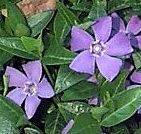
These perennial evergreen vines are a member of the dogbane family, Apocynaceae, that also includes milkweed, oleander, and bluestar. They are native to Europe, northwest Africa and southwest Asia. There is no archaeological evidence that either periwinkle grew in ancient Pompeii but one of them appear to be pictured in a wall painting in the House of the Golden Bracelet. The ancient Roman naturalist, Pliny the elder (d 79 A.D.), tells us that ” Taken in vinegar, it [periwinkle] is very useful for the stings of serpents, that of the asp in particular.” He also notes that “although [perwinkle is] more generally used for the purposes of ornamental gardening, it is sometimes employed in chaplets when there is a deficiency of other flowers.” Pliny makes no distinction between the species of periwinkle but scholars feel sure that caplets were made in ancient Pompeii and could have included perwinkle. Photo Credit Wikipedia
Description: The plants have slender trailing stems that root at the nodes to form dense low-growing leafy mats. The glossy, leathery, dark green leaves are opposite, broadly lanceolate to ovate, and .5-3.5″ long. The tubular flowers appear in the spring and sporadically in summer and fall and consist of 5 violet petals joined at the base. The species are very similar in appearance but Vinca minor has smaller flowers and leaves than V. major.
Size: Low growing (6-12″ H)
Light: Part to full shade
Soil: Average, medium moist, well-drained but tolerates some dryness
Hardiness: V. minor Zones 4-9; V. major Zones 7-9